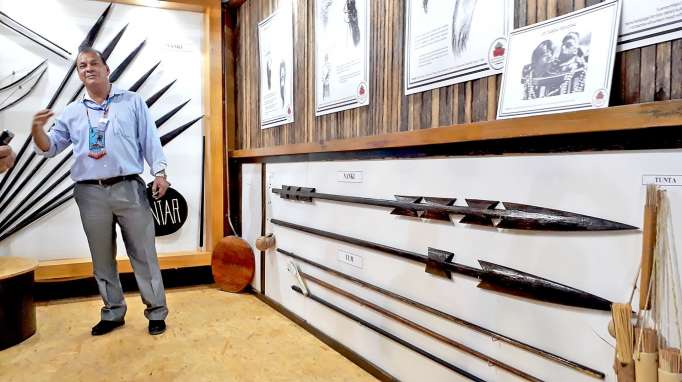Nah, affricans got nerfed pretty hard this patch.
Also US was B tier on launch, so power creep is not really there.
Nah, affricans got nerfed pretty hard this patch.
Also US was B tier on launch, so power creep is not really there.
My guess : Persians , finger crossed… Italians would be great as well
One very curious think: they updated one of the unused civ theme:
Look at the Barbary Coast song
https://www.youtube.com/watch?v=MEfy4mHGn8s
If you remember correctly, there was already a song for Barbary Coast before (with Ethiopian). However, they did update it (possibly with AR update).
I dont think they ever adressed issues with Ports except on game balance, so I have my doubts.
Unfortunately JonOli which was one of the few that offered suggestions for Ports is currently banned.
Did they change the Portuguese theme? It sounds different now, or rather it no longer has that feeling of ‘melancholy’ from the vocals.
But like I said expecting an entire rework of a civ is out of the realm of possibility. Sure, it would make the game more historically accurate but it’s not gonna sell the game to people. More content will.
There’s no financial incentive to rework the old civs. No one is gonna buy the game because of reworking old civs. In fact, there would most likely be a backlash from existing players. tweaks? yes, reworks? no.
Reworking ports from scratch is an unreasonable request.
I dont think anyone ever requested a rework from scratch, despite being a bit bland civ.
It would be an incentive for me for example because at the moment I have none.
Merc changes, especially replacing Mameluks and Barbary Corsairs, is definitely needed.
I can stomach Organ Guns and Goons, but having the main enemies on the atlantic and early expansion on the Indian Ocean as mercs makes no sense.
And especially because one of the main Port strat is basically mameluks.
( not to mention religious enemies)
I think there might have been some confusion with:
Mameluco is a Portuguese word that denotes the first generation child of a European and an Amerindian. It corresponds to the Spanish word mestizo .
To the literal Mameluks from Egypt.
Edit: altough I would replace organ guns for
Is that a basilisk cannon?
A small Breach Loading Cannon.
It had a high rate of fire, as several chambers could be prepared in advance and quickly fired in succession and was especially effective in anti-personnel roles.
It’s literally the same role as organ gun, pic is from a Portuguese museum.
Possibly they are the Italians,Poland-Lithuania,Persia,Korea or Denmark…
Maybe it can be the Zulus…
Badly forget,it must be the best patch in the history of rts…it’s practically a new game…
Thanks for all the information on them, they do sound fascinating. My main hangup for them being a fully playable faction versus a tribal ally would be this bit of the article you linked:
One unusual characteristic of the Jivaro is the complete lack of any political organization. There are no tribal leaders or community organizations. The sole unit of organization is the family group. However, in times of war, two or more villages may unite to fight a common enemy, as was the case when the Spanish attempted to conquer them. The Jivaro population is widely dispersed, with an average of 1.5 km to 8 km (1–5 mi) between houses. Families live in a house for no more than 10 years, as the nearby supply of firewood and small game becomes depleted. Families will then move a few kilometers or miles away to an area richer in resources.
I think they would need a bit more of a centralized and cohesive organization to qualify as a playable faction. It seems like they are more of a culture group rather than a proper political entity. Maybe their coalition against the Spanish and Inca lead to some type of unifying command, but it would be hard to say without more information which seems to be hard to come by. The most primitive faction in the game is the Sioux and they have a confederation in the Seven Council Fires. If there’s more information on what kind of army the Jivaro had to fight off the Spanish and what type of units they might have to fill their roster, then maybe they’d be viable, but it doesn’t seem like that’s easy information to find if it is at all available from a people without writing that killed any potential Spanish or Incan chroniclers.
There is a lot of information, but for that you will have to read a lot of books. Although it is true that the Jivaros murdered almost all the Spaniards (and probably Incas) who entered their territory, there are direct bibliographic sources through Jesuit records, as is the case of Father Juan de Velasco.
I don’t like comparing American tribal organizations, but keep in mind that the Sioux population (Lakota, Santee, Yankton, and Yanktonai) was estimated at 28,000 in 1660, while in the Jivaro Rebellion of 1599 the Jivaro army was estimated to be made up of about 20,000 warriors* (much higher than the 1,500 Iroquois led by Joseph Brant who participated in the American Revolutionary War). As a curious fact, who managed to unite and lead the entire army was Kirup (Quiruba or Kirrúba), who according to some sources was a Jivaro-Spanish mestizo, this leader was supported by other Jivaro leaders: Pincho, Chimbo and Palacali; so they may have had a tribal organization, but a tribal organization similar to that of the Sioux or even similar to the Iroquois confederation.
With regard to Jivaro’s weapons and military tactics: remember that they are a living culture, many of their ancestral knowledge is maintained to this day, in addition there is information in museums and photographs.



On their military tactics: they preferred to attack on moonless nights and used poisons. A civilization specialized in ambushes that have different types of poisons perhaps?


*Edit: According to the narratives, they did not attack as a compact army but in groups of 500-1,000 warriors from different directions.
So are you from Ecuador to be able to have access to those museums and such? To me, it still seems like a stretch to make them a playable faction but they would definitely be an awesome minor civ. Maybe it’s location bias because I think tribes closer to me like the Cree (Iron Confederacy) or Hiada would make cool playable factions. The Cree were really involved in the fur trade and aided Metis rebellions. The Haida are a small tribe at least now but they had impressive canoes, artwork, fortifications, and even used captured artillery so there is a lot to work with to flesh out a unit and building roster.
True, the North American factions have shockingly small populations. It makes the decision to rename Sioux to the more specific Lakota kinda strange. But if population is a requirement then Mapuche or Guaraní would make more sense as South American playable factions.
i think the most important thing for south america is to add more minor natives into the games/maps, there are other more appropriate cultures/nations to make into factions, and south america is rather lagging in native options.
I know it very well if you know what I produce but it will not change anything to place the IA block,
I have tried every possible way and it doesn’t work
Hehe, I’m not Ecuadorian. But in several museums you can see the culture of the Jivaros (which reminds me of the controversy of the retreat of the Tzantza that were on display in the British museum in Oxford). I want to make it clear that I do not look down on tribal American civilizations, they are all fascinating and have something to teach. I also admit that my knowledge is defined by my geography, I worked for a while in the Amazon rainforest and I had as a coworker a Shawi (Amazonian ethnic group related to the Jivaros) who always told me stories of his culture, he had spent his childhood in his “village” when a missionary helped him get a scholarship to study in the city (yes, there are still Amazonian tribal villages and there are still missionaries who are going to visit them).
Do not get me wrong, I did not want to contemptuously compare the difference in populations, what I was referring to is that it was very unfair to think that the Jivaros did not have some kind of tribal organization considering that they were able to mobilize a considerable army of 20,000 warriors and also distribute them in semi-independent attack fronts, in addition to the fact that they were kept together under some kind of organization when they resisted the attempts of Spanish conquest, in addition to the fact that there are records that the Spanish traded with the Jivaros in the mid-16th century.
But with regard to the Jivara population, keep in mind that it refers to all the ethnic groups that speak the Jivaro language, which include the Aguaruna, Shuar, Achuar, Shiwiar, Huambisa ethnic groups, etc.
From what I understand, to count the Guaraní and Mapuche populations, all ethnic groups related to their language are also counted, which is why the size of the Jívara population during the 16th century was similar to that of the Guaraní and Mapuches (As a curious fact, the largest armies documented by the Guaraní and Mapuches did not exceed 10,000 warriors).
I agree with you, for now you have to prioritize the poor geographic distribution of South America in AoE 3 before thinking about adding more Native American civilizations. Currently there are 4 Native American civilizations that are superior to the 3 Asian civilizations and 2 African civilizations, so it can be considered that America is well represented for now.
As a personal opinion, there could be an Amazonian map where the Jivaros with the Jesuits are present (in the future the Jivaro could be replaced with the Aguaruna)
Earwax or huzzah…, also  … nothing
… nothing